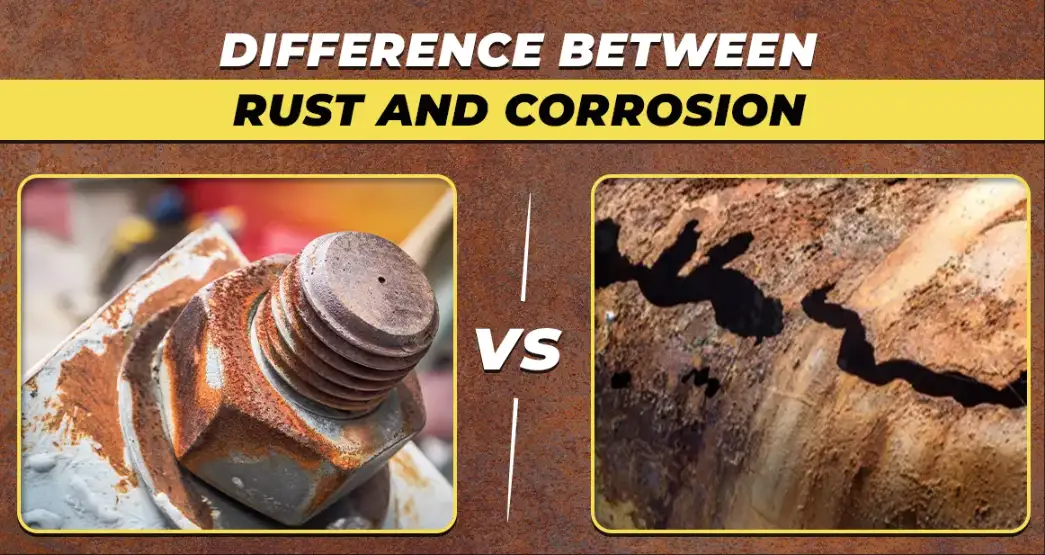في عالم علوم وهندسة المواد، يعد فهم ظواهر الصدأ والتآكل أمرًا بالغ الأهمية للحفاظ على طول عمر الهياكل المعدنية وسلامتها. وعلى الرغم من أن الصدأ والتآكل غالباً ما يستخدمان بالتبادل، إلا أنهما عمليتان مختلفتان لهما آثار مختلفة على المواد. يتطرق هذا الدليل الشامل إلى الاختلافات بينهما وأسبابها وآثارها وطرق الوقاية منها.

ما هو التآكل؟
التآكل هو عملية كهروكيميائية طبيعية تؤدي إلى تدهور المعادن بسبب التفاعلات مع العناصر البيئية مثل الأكسجين أو الماء أو الأحماض أو الأملاح. ويشمل مجموعة واسعة من التفاعلات التي تتجاوز مجرد تكوين الصدأ. يمكن أن يؤثر التآكل على معادن مختلفة، بما في ذلك الحديد والألومنيوم والنحاس وسبائكها.
أنواع التآكل
-
التآكل المنتظم: يحدث بالتساوي عبر سطح المعدن، مما يؤدي إلى ترقق تدريجي للمادة.
-
التآكل الناجم عن التأليب: تآكل موضعي يؤدي إلى تكوين حفر أو ثقوب صغيرة على سطح المعدن.
-
التآكل الجلفاني: يحدث ذلك عندما يتلامس معدنان غير متشابهين كهربائيًا في وجود إلكتروليت، مما يتسبب في تآكل أحد المعدنين بشكل أسرع من الآخر.
-
تآكل الشقوق: يحدث في الأماكن الضيقة حيث يكون وصول سائل التشغيل محدودًا، مما يؤدي إلى تآكل موضعي.
-
التآكل بين الخلايا الحبيبية: يحدث على طول الحدود الحبيبية للمعدن، وغالباً ما يكون ذلك بسبب الشوائب أو عناصر الإشابة.
ما هو الصدأ؟
الصدأ هو نوع محدد من التآكل الذي يحدث عندما يتفاعل الحديد أو سبائكه، مثل الصلب، مع الأكسجين والرطوبة بمرور الوقت. وينتج التفاعل الكيميائي أكاسيد الحديد، والمعروفة باسم الصدأ، والتي تظهر عادةً على شكل مادة بنية محمرّة متقشرة على سطح المعدن.
التفاعل الكيميائي لتكوين الصدأ
يتضمن تكوين الصدأ العديد من التفاعلات الكهروكيميائية:
-
الأكسدة عند الأنود: يفقد الحديد (Fe) الإلكترونات لتكوين أيونات الحديد (Fe²⁺).
-
الاختزال عند القطب السالب: ويكتسب الأكسجين (O₂) والماء (H₂O) إلكترونات لتكوين أيونات الهيدروكسيد (OH-).
-
تكوين هيدروكسيد الحديد: تتفاعل أيونات الحديد (Fe²⁺) مع أيونات الهيدروكسيد (OH-) لتكوين هيدروكسيد الحديد (II).
-
الأكسدة إلى أكسيد الحديد: ويتأكسد هيدروكسيد الحديد (II) كذلك لتكوين أكسيد الحديد (III)، المعروف باسم الصدأ.
تتسارع هذه العملية في وجود شوارد مثل المياه المالحة التي تسهل حركة الأيونات.
الاختلافات الرئيسية بين الصدأ والتآكل
| أسبكت | التآكل | الصدأ |
|---|---|---|
| التعريف | مصطلح عام للتدهور المعدني | نوع محدد من التآكل الذي يصيب الحديد |
| الحدوث | يؤثر على المعادن المختلفة | يؤثر في المقام الأول على الحديد وسبائكه |
| المظهر | يختلف (على سبيل المثال، البهتان على الفضة، والزنجار على النحاس) | مادة قشارية بنية مائلة إلى الحمرة |
| الطبقة الواقية | يمكن أن تشكل بعض الأشكال طبقات أكسيد واقية | لا توجد طبقة واقية؛ مما يسرع من التآكل |
| العملية الكهروكيميائية | تنطوي على تفاعلات انتقال الإلكترون | ينطوي على تفاعلات محددة تؤدي إلى أكاسيد الحديد |
أسباب الصدأ والتآكل
العوامل البيئية
-
الرطوبة: الماء مكون رئيسي في كل من عمليات الصدأ والتآكل.
-
الأكسجين: ضروري لتكوين الأكاسيد في التآكل والصدأ.
-
الأملاح: يؤدي وجود الأملاح، خاصةً في البيئات البحرية، إلى تسريع التآكل.
-
الأحماض: يمكن أن تؤدي الظروف الحمضية إلى تآكل المعادن بشكل عدواني.
العوامل المادية
-
تركيبة السبيكة: قد تتآكل المعادن التي تحتوي على عناصر إشابة معينة بشكل مختلف.
-
تشطيب السطح: الأسطح الخشنة أو التالفة أكثر عرضة للتآكل.
-
الطلاءات الواقية: يزيد عدم وجود طلاءات واقية من التعرض للتآكل.
آثار الصدأ والتآكل
السلامة الهيكلية
يؤثر كل من الصدأ والتآكل على قوة وثبات الهياكل المعدنية، مما يؤدي إلى أعطال محتملة في الجسور وخطوط الأنابيب والآلات.
الأثر الاقتصادي
إن تكلفة إصلاح المكونات المتآكلة أو استبدالها كبيرة، مما يؤثر على الصناعات على مستوى العالم. على سبيل المثال، تنفق وزارة الدفاع الأمريكية حوالي $23 مليار دولار سنويًا على القضايا المتعلقة بالتآكل .
الشواغل البيئية
يمكن أن يؤدي التآكل إلى تلوث البيئة، خاصةً عندما تتسرب المواد الخطرة من الحاويات أو خطوط الأنابيب المتآكلة.
طرق الوقاية
الطلاءات الواقية
يمكن أن يؤدي تطبيق الدهانات أو الجلفنة أو الطلاءات الأخرى إلى حماية المعادن من العوامل البيئية.
الحماية الكاثودية
يمكن أن يؤدي ربط مادة أكثر أنودية (مثل الزنك) بالهيكل المعدني إلى منع التآكل عن طريق التضحية بنفسه.
التحكم البيئي
الحد من التعرض للرطوبة والأكسجين والعوامل المسببة للتآكل يمكن أن يقلل من مخاطر التآكل.
اختيار المواد
يمكن أن يؤدي اختيار مواد أو سبائك مقاومة للتآكل إلى تعزيز طول العمر الافتراضي.
الأسئلة الشائعة (FAQs)
1. هل كل التآكل صدأ؟
لا، ليس كل التآكل صدأ. يشير الصدأ على وجه التحديد إلى تآكل الحديد وسبائكه. وتخضع معادن أخرى لعمليات تآكل مختلفة، مثل التلطيخ في الفضة أو تكوين الزنجار في النحاس .
2. هل يمكن الوقاية من الصدأ؟
نعم، يمكن الوقاية من الصدأ من خلال تطبيق الطلاءات الواقية، واستخدام مواد مقاومة للتآكل، واستخدام طرق مثل الحماية الكاثودية .
3. ما هو دور الملح في التآكل؟
يعمل الملح كإلكتروليت، مما يسهل حركة الأيونات ويسرع عملية التآكل، خاصة في البيئات البحرية.
4. كيف يؤثر التآكل على البنية التحتية؟
يمكن أن يؤدي التآكل إلى إضعاف المكونات الإنشائية، مما يؤدي إلى حدوث أعطال في الجسور وخطوط الأنابيب والمباني، مما يشكل مخاطر على السلامة ويتسبب في تكبد تكاليف إصلاح كبيرة.
5. هل هناك طرق صديقة للبيئة لمكافحة التآكل؟
نعم، تشمل الأساليب الصديقة للبيئة استخدام مثبطات قابلة للتحلل الحيوي، واستخدام الطلاءات غير السامة، واستخدام التقنيات الصديقة للبيئة لمنع التآكل.
الخاتمة
يعد فهم الاختلافات بين الصدأ والتآكل أمرًا ضروريًا لإدارة تآكل المعادن ومنع تآكلها بفعالية. في حين أن الصدأ هو نوع محدد من التآكل الذي يؤثر على الحديد، فإن التآكل يشمل مجموعة واسعة من التفاعلات التي تؤثر على المعادن المختلفة. من خلال تنفيذ استراتيجيات الوقاية المناسبة، يمكن التخفيف من الآثار الضارة لهذه العمليات، مما يضمن طول عمر وسلامة الهياكل المعدنية.
